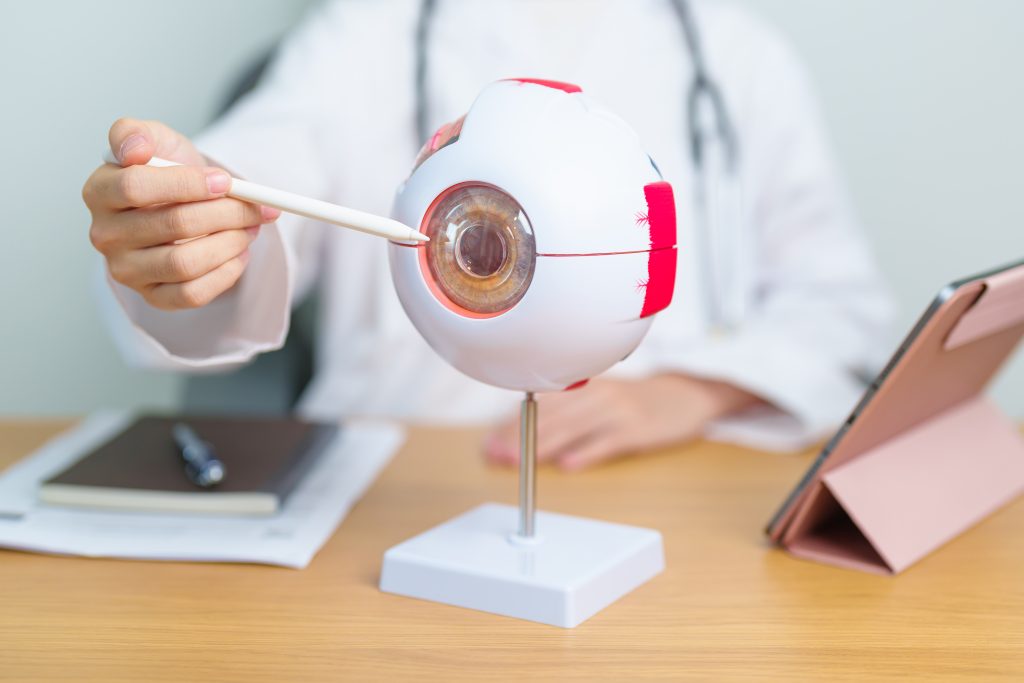What is glaucoma?
Glaucoma refers to a collection of eye conditions that have the potential to result in vision loss and blindness. These conditions arise from the destruction of the optic nerve situated at the back of the eye.

The symptoms of glaucoma can begin gradually, making them easy to miss. The only way to determine if you have glaucoma is by undergoing a thorough dilated eye exam.
Although there is no known remedy for glaucoma, it is commonly found that receiving prompt treatment can prevent further harm and safeguard one’s eyesight.
What Is the Main Cause of Glaucoma?
Your eye produces a constant amount of a liquid called aqueous humor. As the new aqueous humor enters your eye, an equal amount is supposed to drain out. This draining process happens through a specific area known as the drainage angle. Its purpose is to maintain a stable pressure in the eye, also called intraocular pressure or IOP. However, if the drainage angle is not functioning correctly, the fluid accumulates. Consequently, the pressure within the eye increases, leading to harm to the optic nerve.
The optic nerve is composed of over a million small nerve fibers, resembling an electrical cable consisting of numerous wires. When these nerve fibers start to die, it results in the formation of blind spots in one’s vision. These blind spots may go unnoticed until a significant portion of the optic nerve fibers have perished. If all the fibers perish, a person will lose their eyesight and become blind.
WHAT ARE THE SYMPTOMS OF GLAUCOMA?
- Vision loss can occur gradually or suddenly, manifesting as blurred vision, narrowed or tunneled vision, and areas of complete blindness.
- Severe eye pain can occur in the case of acute angle-glaucoma.
- Headaches / Migraines
- Red eyes
- Halos around lights
- Nausea and vomiting (in severe cases)
Regrettably, half of the individuals suffering from this illness are oblivious to their eye health problems, since there are usually no initial indicators. Glaucoma earns the nickname “Silent Thief of Sight” because vision remains intact until the late stages of the disease, when irreversible and permanent harm has already taken place.
Early identification and treatment of diseases, including regular follow-ups, play a vital role in reducing eye pressure and minimizing potential damage over time.
What are the types of glaucoma?

There are multiple forms of glaucoma, which include:
Open-angle glaucoma
The most prevalent form of glaucoma in America is this variant, which affects up to 90% of people with the condition. It occurs when there is increased resistance in the drainage canals of the eye. These canals seem to be unclogged and working properly, but over time, fluid accumulates in the eye and puts pressure on the optic nerve. Many individuals may not realize they have this disease for a long time because it typically doesn’t cause any noticeable symptoms.
Angle-closure glaucoma
It is more prevalent in Asia and is referred to as acute angle-closure glaucoma, chronic angle-closure glaucoma, or narrow-angle glaucoma. The normal drainage of your eye is hindered when the space between your iris and cornea becomes too narrow, resulting in a sudden increase in eye pressure. It is also associated with farsightedness and cataracts, which is the clouding of the lens within your eye.
Congenital Glaucoma
Babies who are born with congenital glaucoma have an issue with the way their eye angle is formed, which hinders or stops the normal flow of fluid. Typically, signs of congenital glaucoma include cloudy eyes, excessive tears, and sensitivity to light. It’s also possible for congenital glaucoma to be hereditary.
Secondary glaucoma
Secondary glaucoma, known as Neovascular glaucoma, can arise as a result of various other eye diseases or conditions such as diabetes, asthma, and COPD (caused by prolonged use of steroids or corticosteroids for more than three months), as well as a tumor and individuals who have had Covid 19, among others.
Normal-tension glaucoma
Up to 33% of individuals experience optic nerve damage even if their eye pressure is within normal or slightly elevated levels. The reason behind the development of normal-tension glaucoma remains unclear as experts are uncertain about its cause. This form of glaucoma is also referred to as normal-pressure or low-tension glaucoma and is more frequently observed in individuals of Asian descent or Asian Americans.
What are the treatments for glaucoma?

Although there is currently no cure for glaucoma, there are several ways to slow down its advancement. The choice of treatment depends on the stage of the disease and whether the patient is suitable for a particular treatment option.
There are three categories in which treatment options can be classified.
Medications to treat glaucoma
Various kinds of prescription eye drops are available to treat glaucoma. Some can reduce fluid buildup and enhance the drainage system to alleviate eye pressure. Since glaucoma is a chronic condition, it may be necessary for you to apply these eye drops regularly for the rest of your life. There may be instances where you need to use them multiple times a day.
The FDA has given its approval for a new way to administer bimatoprost, a treatment for glaucoma that was previously available only in the form of eye drops. The new method involves an implant that dissolves slowly and provides relief for several months. This implant, called Durysta®, is inserted into the eye by your eye care provider. However, it is important to note that currently, this implant can only be inserted once in each eye.
Minimally invasive glaucoma surgeries.
This advanced type of surgery is more modern and involves smaller incisions, utilizing equipment that is not visible to the naked eye. It is typically quicker and safer, although it may not decrease pressure to the same extent. Additionally, it can be performed simultaneously with other procedures like cataract surgery.
Laser surgery

There are two primary forms of laser surgery used in the treatment of glaucoma, which aid in the drainage of aqueous fluid from the eye. Typically, these procedures are conducted either at the ophthalmologist’s office or an outpatient surgery center.
- Trabeculoplasty is a surgical procedure offered to individuals with open-angle glaucoma as an alternative or a complementary treatment to medication. During this procedure, a laser is utilized by the eye surgeon to enhance the functionality of the drainage angle. This enables proper fluid flow and leads to a decrease in eye pressure.
- An iridotomy procedure is performed on individuals experiencing angle-closure glaucoma. In this procedure, a specialist utilizes a laser to establish a small aperture within the iris. This aperture aids in facilitating the movement of fluid towards the drainage angle.
In certain situations, one surgery may not effectively slow down the advancement of glaucoma. The possibility of undergoing multiple surgeries and/or ongoing use of medications may be required.
Glaucoma can lead to permanent loss of vision if not treated.
Contact your healthcare provider if you experience new symptoms of glaucoma or other eye problems, or if existing symptoms worsen.
Treatment in Türkiye:
The medical staff of surgical teams, doctors, and consultants at REHABTÜRK can provide the best treatment options and free consultations, striving to stay up-to-date on the latest medical technologies and methods.
